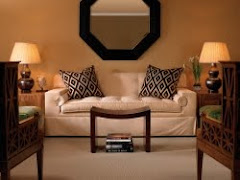Dining Rooms and Dining Areas
Dining rooms and dining areas still look best, and certainly more romantic, by candlelight, but make sure that candles are either above or below eye-level, and not flickering directly in the diners’ eyes. Candlelight combined with a down-light, like a nice chandelier, and controlled by dimmer switches, is better still. The serving area should be lit separately, perhaps by a well-angled spot or down-light.
Halls, Corridors, and Staircases
Far too many halls and staircases have inadequate lighting. They should, of course, be well lit at all times, with light on the floor to show any changes in levels and surfaces, and light on the walls to show switches and door handles. When starting a lighting plan from scratch, the ideal would be to have a separate circuit of low-level lights that could be left on at all times. But this is an ideal, and seldom achieved.
Bedrooms
Bedside lamps should be high enough to shine directly onto a book. Light above a mirror used for make-up is less helpful than light placed at either side. Lights positioned to shine outwards, rather than on the mirror itself, are much better. The same applies to full-length mirrors, where the light should be directed on to the viewer rather than on to the glass.
Children’s Rooms
In small children’s rooms, all outlets should be childproof and lighting fixtures kept well out of reach. Wall lights are useful here for they will give a softer light than that of central ceiling fixtures. Dimmer switches are useful for children who are afraid of the dark; alternatives are the very low wattage baseboard or skirting fixtures. Older children will need good light for homework, hobbies, and for reading in bed. So provide adequate lighting on desks and worktables, and above beds, set in good positions.
Stay tuned for tips for bathrooms, kitchens and outdoor areas...
Subscribe to:
Post Comments (Atom)










No comments:
Post a Comment